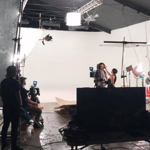How would COVID-19 safety protocols have affected 2000’s “Erin Brockovich?” Epitome's Pandemic Production Safety Experts examine this Soderbergh classic.

Let’s celebrate one of the toughest working moms to ever grace the silver screen: Erin Brockovich. Based on the real life of its title character, 2000’s “Erin Brockovich” is a studio film masquerading as an indie movie.
Brockovich’s life was adapted for the screen by Susannah Grant and directed by Steven Soderbergh. As Peter Biskind details in his classic chronicle of the era, “Down and Dirty Pictures,” Soderbergh is one of the founding members of the 1990’s indie film revolution. He brought all his low-budget aesthetics to this big-budget legal drama.
It is easy to imagine another director using the film’s $52 million to give it that mid-budget adult movie sheen, but Soderbergh and DP Ed Lachman bleached it out and came with truckloads of grit and sweat.
Julia Roberts stars as a down and out single mother who – through sheer force of will and determination – exposes a massive corporate coverup and helps change the fate of an entire town. Pacific Gas & Electric (PG&E) knowingly poisoned the people of Hinkley, California, causing all manner of cancers, suffering, and loss. PG&E then covered their tracks and denied all wrongdoing.
Enter Erin Brockovich, unemployed single mother of three whose brash attitude loses her a sure-thing car-accident court case. She shows up at her work-a-day lawyer’s office and demands a job since the lawyer, Ed Masry (Albert Finney), promised her that her case would turn out okay.
Reluctantly, Masry agrees and give her a real estate case file with a few loose ends involving PG&E’s attempt to purchase a house in Hinkley. Brockovich pulls on those loose ends and discovers the case of the century.
What follows is a thrilling, heartfelt legal drama that took the country by storm in 2000. “Erin Brockovich” opened #1 at the box office on March 17, 2000, grossing over $28 million on its opening weekend. It was number one for three consecutive weekends, remained in the top ten for three months, and ended the year with a worldwide haul of over $250 million.
Nominated for five Academy Awards, “Erin Brockovich” was critically acclaimed and loved by audiences. Julia Roberts became the first female actor to win the Oscar, the Golden Globe, the SAG Award, the Critic’s Choice Award, and the BAFTA for best lead performance.
The American Film Institute (AFI) ranks the character of Erin Brockovich among the greatest screen heroes of all time. This film is filled to the brim with memorable scenes – “two wrong feet,” the town meeting scene, the numbers scene, “I’m really quite tired,” and the heartwarming ending – but none of them are quite as unforgettable is as the “lame-ass offer” scene from film’s mid-point:
Let’s take a closer look at this pivotal, fist-pump-inducing scene with an eye toward COVID-19 safety. To do this, we’ve broken it down into three sections:
- Elements that are COVID-19 Safe
- Elements that are COVID-19 Risks
- Strategies to increase safety
Let’s begin by looking at the ways this scene is already safe.
Elements That Are COVID-19 Safe
Production began twenty-three years ago, on May 5, 1999. Despite the studio money at his disposal, Soderbergh wanted to film “Erin Brockovich” like an indie movie. To do this, he left the backlots behind and chose real locations for every one of his scenes. This is how this scene ended up in an office in Ventura, California.
No one on set in 1999 was concerned about COVID-19 safety – they weren’t even concerned about updating their social media status – and yet there are elements of this scene that are COVID-19 safe.
We would like to highlight three:
- Small Cast
- Location Control
- Simple Shots
Small Cast
This is the first major showdown between Masry’s underfunded law firm and the PG&E legal team. The goal at the top of the scene is to establish just how much larger the opposition’s team is. In fact, it inspires Masry and Brockovich to add a few last-minute additions to their side of the table to try and balance things out.
This goal could easily lead to an overstuffed scene with far too many people around that conference table. Soderbergh and company show restraint by keeping the numbers down. The impression still lands but we aren’t looking at a serious safety issue here.
The conference table keeps everyone separated and the chairs aren’t too close together. By keeping the cast small in this scene, the creative team was able to maintain good distancing without sacrificing the desired visual impact.
Location Control
Soderbergh may have been looking for that indie aesthetic, but he found a location he could control. A truly independent film would have found an operational law office and simply asked to shoot in their space after hours or between shifts.
With proper compensation and well-established off-limits areas, most companies would gladly make some extra money without much effort on their parts. By choosing a location that was not in use and one that he could shut down, Soderbergh and company established a baseline level of location control that is vital for COVID-19 safety.
Simple Shots
The indie vibe continues when we look at Soderbergh’s shot selection here. He is certainly a director capable of innovative and eye-catching shots, but here he trusts the story, the actors, and the dialog to land without anything more than a series of shot, reverse shot.
Simple shots require fewer crew members and less time to set up, complete, and tear down. This not only saves time and money, but it makes the scenes safer. Fewer people means fewer opportunities for contamination and a faster shot means everyone can get out of the danger zone more quickly.
By not overloading the cast in this scene, choosing a controllable location, and sticking with simple shots, the production team on “Erin Brockovich” was able to establish a solid foundation for COVID-19 safety.
But there are still some risks. Let’s take a look at those.
Elements That Are COVID-19 Risks
This wonderful scene lands so powerfully and triumphantly because our seemingly outmatched team blindsides the smug opposition by being more prepared and more aggressive than anticipated. PG&E underestimated who they were dealing with, and after this moment, they don’t make that mistake again.
This dynamic is made all the more powerful by Soderbergh’s aesthetic choices. The costumes, the location, the lighting, and the props all help to make this scene land. But many of those decisions also create some COVID-19 risks.
While there are many problematic issues in this scene, we would like to highlight the three biggest:
- Indoor Location: The CDC has consistently warned against large, indoor gatherings. Movie sets should follow the CDC’s guidelines whenever possible. By filming indoors, the production team has increased the risk of COVID-19 to a potentially dangerous level without several additional steps (which we will get to in a moment).
- Location Choice: On-location shooting is far riskier than shooting on a studio lot or a soundstage. While Soderbergh had a solid level of location control at his chosen real-world office space, he doesn’t have the level of control he could have had working on a studio lot. Built sets have movable walls that can allow the cast and crew far better separation. Studio soundstages have state of the art ventilation systems that can further increase pandemic safety. Given that “Erin Brockovich” is a Universal Studios and Columbia production, we know that Soderbergh had access to great studio space.
- Props: The water and the water glass in this scene concern us. It is just the sort of thing that a thirsty crew member might drink between takes. It is certainly something that multiple people will have to touch, including the actor. Props that actors must bring to their mouths and faces are problematic because it puts potentially contaminated material in close proximity to the parts of the body COVID-19 uses to infect us; our eyes, nose, and mouth.
We think it is possible to mitigate the risks presented by the three issues above without compromising the indie aesthetics and vision of Soderbergh and company.
Strategies to Increase Safety
“Erin Brockovich” is one of the most celebrated movies from the turn of the century and Soderbergh is one of the most talented filmmakers in the business.
We are not trying to say that we could do a better job than Steven Soderbergh and company. We are simply looking at how COVID-19 would affect the production of one of the most crowd-pleasing scenes from any legal drama of the last 25 years.
With the backing of a major studio and a budget that would be unheard of today for a movie this size ($86.5 million in 2022 dollars), the production team behind “Erin Brockovich” had the resources to increase safety. And they could do it rather easily.
Here are three strategies that we would recommend to increase safety.
- Lean into the Imbalance: This movie is a sweaty film and countless scenes involve drenched shirts and impromptu fanning. This scene is also about the perceived power and money imbalance between the two sides. So, let’s lean into both of those. If we opened up all the windows and brought in several oscillating fans, we could increase the stakes of the scene by making Masry’s conference room appear even more small-time. Open windows and fans would also increase air circulation and, in turn, increase pandemic safety.
- Shoot on a Studio Lot: There are many scenes in this movie that benefit greatly from Soderbergh’s decision to shoot on-location. The town of Hinkley, for example, would be hard to recreate on a studio lot. But this scene takes place in an office and a skilled art department and set design team could create an even better – and safer – location on a studio lot. As mentioned above, a built set allows us to move walls and increase spacing which makes the set safer.
- Mark the Problematic Prop: Creating a chain of custody for all problematic props is vital to set safety. In a pandemic, it is important to do this for props that might appear innocuous, like a glass of water. We want to eliminate the possibility that anyone would put a non-sanitized prop close to their face. By marking this prop, sanitizing it between takes, and tracking in throughout the day we could ensure a solid chain of custody and keep anyone from inadvertently causing an outbreak.
We would be sure to highlight these issues during pre-production. It is imperative that everyone have enough time to prepare for safety. By highlighting these issues in the planning stage, weeks if not months before we are on set, we can build in the necessary levels of safety without adding to the schedule or detracting from the flow of the scene.
We would also encourage full vaccination among the cast and crew and follow all the union guidelines on pandemic safety. Good risk management is invisible. Great risk management also supports and accentuates the vision of the creative team.
By increasing the imbalance, shooting on a studio lot, and marking the potentially risky prop we could help the creative team to maximize safety while simultaneously supporting their already dialed-in vision.
Final Thoughts
“Erin Brockovich” is a bona fide classic. Its David and Goliath legal story still holds weight and relevance today. It is a movie about a singular person played by a singular talent made by a one-of-kind director and a team of unbelievably skilled people. Together, these elements create unforgettable scenes and are true rarity: a film that has weight, heart, and a message.
If we had to film the “lame-ass offer” scene from “Erin Brockovich” today, we would second the creative team’s decision to limit the number of lawyers and keep the shots simple.
We’d suggest that Soderberg and company accentuate the financial imbalance between the two legal teams and pump up the summer heat aesthetic by opening lots of windows and turning on some fans. Additionally, we would encourage them to use the production’s budget and studio backing to secure soundstage space for this scene, thereby maximizing location control.
Lastly, we would be sure to mark the prop water glass and ensure that its chain of custody is impeccable so as to limit the chances that the actor who interacts with it (and the crew members who places it at the start of each take) transmits the virus.
In the end, the reason “Erin Brockovich” has such a lasting legacy is because its message is clear and resounding. This is a movie about a woman with no power and no support who saw a wrong in the world and set out to correct it. As executive producer Carla Santos Shamberg said, this movie reminds us “that someone so powerless could do something so important.”
Epitome Risk is a Woman-Owned, Veteran-Run, U.S.-Based risk management company, specializing in risk management and COVID-19 safety support for tv & film productions. Epitome Risk works together with the film unions, insurers, studios, and production companies to make every project as safe as possible.
DISCLAIMER: This information should not be considered comprehensive and is not a substitute for hiring risk management professionals and personnel trained in COVID-19-specific procedures. Please consult with your insurance company, your investors, all applicable union reps, and health and safety professionals before starting production in a pandemic.













Comments
There are no comments on this blog post.